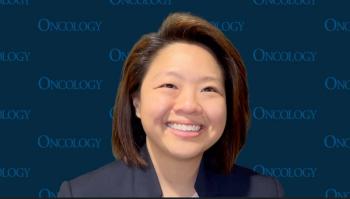
Benefits With Gilteritinib for AML Were Maintained, Regardless of Co-Mutations
The survival benefit observed with gilteritinib in FLT3-mutated relapsed/refractory acute myeloid leukemia in the ADMIRAL trial was maintained regardless of the presence of several common co-mutations.
The survival benefit observed with the FLT3 inhibitor gilteritinib in FLT3-mutated relapsed or refractory acute myeloid leukemia (AML) in the ADMIRAL trial was maintained regardless of the presence of several common co-mutations, according to new data (
Four major co-mutations were identified: NPM1 (47.9%), DNMT3A (31.9%), DNMT3A/NPM1 (23.8%), and WT1 (18.0%). Seven patients (1.9%) had co-mutations in NPM1, DNMT3A, and WT1.
Higher rates of complete remission/complete remission with partial hematologic recovery (CR/CRh) were found in FLT3-mutated disease across all co-mutation–positive subgroups treated with gilteritinib compared with salvage chemotherapy. Additionally, rates of overall survival were higher across all co-mutation–positive subgroups when treated with gilteritinib compared with salvage chemotherapy.
“There is no molecular subtype where we are justified using chemotherapy vs single-agent gilteritinib in this population,” Levis said.
Compared with other co-mutated cohorts, patients with both NPM1 and DNMT3A co-mutations had the greatest survival benefit with gilteritinib. In these patients, the median overall survival on gilteritinib was 10.8 months compared with 5.0 months when treated with chemotherapy.
The median FLT3-ITD allelic ratio was 0.77; therefore, patients with values of 0.77 or greater were classified as high FLT3-ITD allelic ratio, and those with values below 0.77 were classified as low FLT3-ITD allelic ratio.
A comparison of outcomes by FLT3-ITD allelic ratio revealed patients with a high allelic ratio had significantly improved overall survival (7.1 vs 4.3 months; hazard ratio [HR], 0.492; P = .0001) and CR/CRh rates (27.5% vs 10%; P = .010) with gilteritinib compared with salvage chemotherapy. Among patients with low allelic ratio, overall survival was numerically higher with gilteritinib compared with salvage chemotherapy, but it did not reach statistical significance (10.6 vs 6.9 months; HR, 0.795; P = .2719). However, gilteritinib resulted in significantly improved rates of CR/CRh compared with salvage chemotherapy (39.8% vs 18.9%; P = .0081).
Among patients treated with gilteritinib, there was a numerically higher overall survival observed in patients with a low FLT3-ITD allelic ratio compared with a high allelic ratio (10.6 vs 7.1 months; P = .07), but it did not reach statistical significance. In the salvage chemotherapy group, a significantly higher median overall survival was observed in patients with a low FLT3-ITD allelic ratio compared with a high ratio (6.9 vs 4.3 months; P = .0021).
Study discussant
“In particular, patients who are FLT3 mutated and NPM1 positive, and particularly if they are also DNMT3A positive, should receive targeted therapy, as those patients had dismal response rates to traditional cytotoxic chemotherapy,” Ellis said. “Patients with either high or low allelic ratios will respond to gilteritinib but we need to be thinking about more definitive treatment options in this patient population.”
Newsletter
Stay up to date on recent advances in the multidisciplinary approach to cancer.


















































































